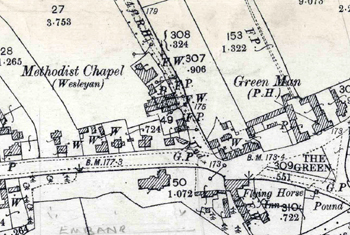
The Wesleyan Methodist chapel shown on an Ordnance Survey map of 1901
Methodism was founded by John Wesley in 1740 but a number of splinter groups broke away from the movement during the next century. Mainstream Methodism became known as Wesleyan Methodism and remained quite close to the Low Church Anglican style of worship, though with a completely different structure. The Wesleyans had built a chapel in Bedford Road in the early 19th century though, being on the west side of the road it was actually in the parish of Maulden, though always referred to as Clophill Wesleyan Methodist church.
The land on which the chapel stood was conveyed on 21st January 1814 by Francis Read of Maulden, yeoman to: Isaac Bradnack of Bedford, Minister of the Gospel; Richard Lovell of Bedford, cordwainer; John Bennett of Flitwick, farmer; John Boddington of Ampthill, schoolmaster, William Stonbridge of Ampthill, straw dealer; Evan Jones of Ampthill, carpenter and Thomas Row of Ampthill, straw dealer [ref: Z210/144]. The land cost £10 and the purchasers "out of monies partly subscribed by or collected from the Society of Methodists and partly borrowed for the purpose erected a chapel for the purposes of divine worship by the Methodist Society". This indicates that the chapel was built before the date of the deed, 21st January 1814, suggesting most of it was built in 1813, being finished in 1814. Nevertheless a tablet above the door stated, according to a notebook of Dr. Edmund Castell [ref: AD3869/6, page 141]:
ERECTED
1814
ENLARGED
1886
This chapel was registered with the Archdeaconry of Bedford on 16th February 1818 by Francis Read and others [ref: ABN1/2, ABN3/3].
The Ecclesiastical Census was carried out on 30th March 1851 and was designed to show the numbers attending places of worship. The Bedfordshire returns were compiled by David W. Bushby and published in 1975 as Bedfordshire Historical Record Society Volume 54. The return for the Wesleyan Chapel in Maulden was completed by Walter Coates of Ampthill, minister. He noted that the chapel had 170 free seats, 120 other seats and standing room for 40 - a total capacity of 330. That afternoon 81 adults and 38 Sunday Scholars had attended, with a general congregation of 124 in the evening. The averages for the preceding twelve months had been 80 general congregation and 38 Sunday Scholars in the afternoon and 125 general congregation in the evening. The minister also noted: "The Wesleyan Chapel is commonly called Clophill Wesleyan Chapel being contiguous to Clophill".
On 17th February 1854 the Wesleyan Chapel was again registered for worship. It was registered by William Henry Clarkson of Harpur Street, Bedford, superintendent minister.
The Wesleyan, Primitive and United Methodists came together in 1932 as the Methodist Church of Great Britain. On 3rd July 1934 the County Surveyor informed the Wesleyan congregation that: "the scheme has been submitted to the Ministry of Transport for their preliminary observations and from these it is quite clear that the whole of the Chapel building will have to be demolished" [MB1516]. Dr. Castell's notebook, quoted above, notes that the chapel was: "now Oct 18th 1937, being demolished". The notebook went on: "The sole memorial in the interior was a white veined marble tablet about 8 inches by 20 inches which has the following inscription":
"Erected by the Congregation and
Family to the memory of
Jesse Burgoine
For 32 Years a Member of
This Church
Died Aug 23rd 1918
Aged 68 Years.
Peace Perfect Peace"
The registration of the old chapel was replaced by that of the new chapel in the High Street on 15th February 1938.